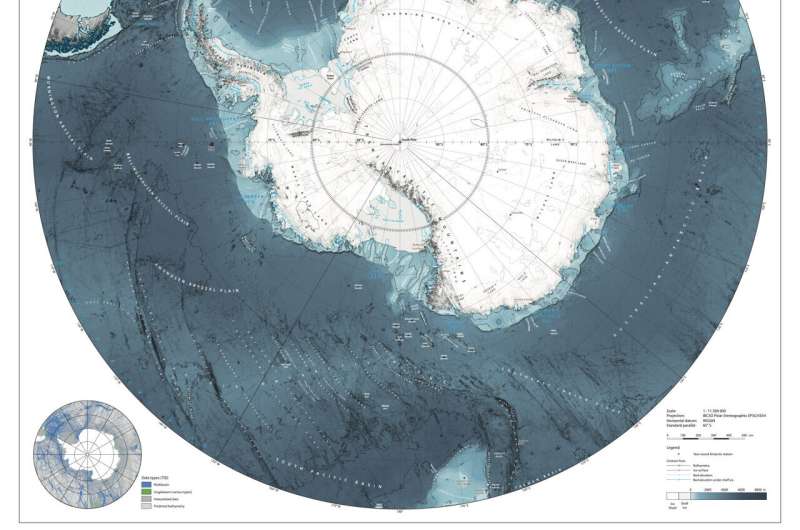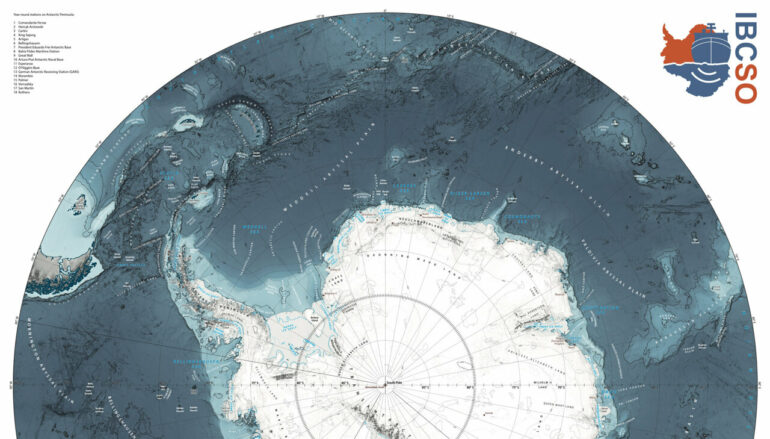The features of the ocean floor help determine how water masses and ocean currents move and how they affect our climate. Biodiversity is also influenced by seafloor landforms. Accordingly, having as precise information on the seafloor topography as possible is indispensable for oceanographic and climate research. With the second version of the International Bathymetric Chart of the Southern Ocean (IBCSO v2), an international group of researchers led by the Alfred Wegener Institute recently presented the best and most detailed seafloor map of the Southern Ocean, which plays a pivotal role in the Earth system. The map and the complex methods used to create it were published in Scientific Data.
Encircling the Antarctic continent, the Southern Ocean is a key region for the Earth system and the global climate. Here, the Antarctic Circumpolar Current, driven by powerful westerly winds—the infamous “Roaring Forties”—represents the key connecting element in the globe-spanning thermohaline circulation, influencing ocean currents in the Pacific, Atlantic and Indian Oceans. In addition, the cold water of the Southern Ocean absorbs tremendous amounts of CO2 and heat from the atmosphere, creating a temporary buffer for many of the negative consequences of anthropogenic climate change. Moreover, these waters are characterized by high biological productivity and are home to a unique diversity of species.
Despite its great significance, in the Southern Ocean—as in many other oceans—only comparatively few regions of the seafloor have been surveyed and charted in detail. Although satellite data covers the whole ocean, it offers comparatively low resolution. Currently, high-resolution data can only be gathered using ship-based methods. As a result, multibeam echosounder readings taken in the Southern Ocean by research vessels like the icebreaker Polarstern often yield previously undiscovered topographical highlights like a 1,920-meter seamount, which was dubbed the Madiba Seamount in honor of Nelson Mandela’s nickname.

© Scientific Data (2022). DOI: 10.1038/s41597-022-01366-7
“No matter where you travel or work, you need a map for orientation. That’s why virtually all oceanographic disciplines rely on detailed maps of the ocean floor,” explains Dr. Boris Dorschel-Herr, Head of Bathymetry at the Alfred Wegener Institute, Helmholtz Center for Polar and Marine Research (AWI). “For example, the seafloor topography of the Southern Ocean is essential to understanding a range of climate-relevant processes. Warm water masses flow into deep troughs in the continental shelf towards the ice shelves and glaciers of the Antarctic, affecting how they melt. Conversely, the stability and calving behavior of glaciers and ice sheets greatly depend on the features of the ground beneath them. With the IBCSO v2, we have delivered the best and most detailed representation of the Southern Ocean to date.”
The International Bathymetric Chart of the Southern Ocean (IBCSO) is an international project coordinated by the AWI and tasked with charting the Southern Ocean. The first IBCSO digital bathymetric model (IBCSO v1) and high-resolution map of the area south of 60°S were released in 2013. In the years since then, the amount of new measurement data has grown considerably.
Since 2017, IBCSO has been part of the Nippon Foundation—GEBCO Seabed 2030 Project, which has set itself the ambitious goal of surveying all the world’s oceans by 2030. “The new version of IBCSO—IBCSO v2—for the Southern Ocean now covers the entire area south of the 50th parallel—which means 2.4 times as much seafloor as the first version—at a high resolution of 500 by 500 meters,” explains Dorschel-Herr. “As a result, the Antarctic Circumpolar Current and the key oceanographic ‘gateways’ essential to understanding it—the Drake Passage and the Tasmanian Passage—are included in their entirety. The chart is based on more than 25.5 billion measurements supplied by 88 institutions in 22 countries.”
More information:
Boris Dorschel et al, The International Bathymetric Chart of the Southern Ocean Version 2, Scientific Data (2022). DOI: 10.1038/s41597-022-01366-7
The International Bathymetric Chart of the Southern Ocean Version 2 (IBCSO v2). PANGAEA, doi.org/10.1594/PANGAEA.937574
Provided by
Alfred Wegener Institute
Citation:
New map shows seabed of the Southern Ocean in unprecedented detail (2022, June 9)



